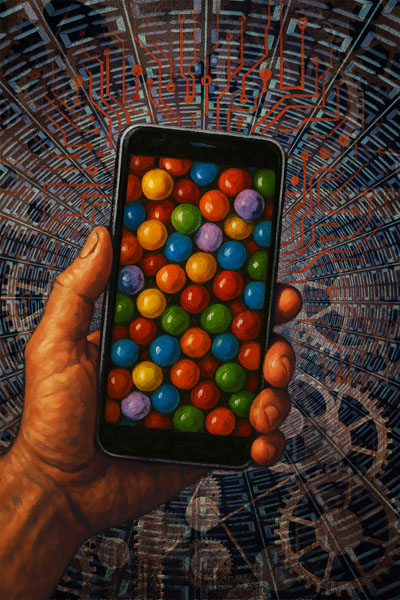In the Grip of the Smart Machine
The smartphone, that high-tech device that constantly sends, radiates, beeps and offers, steals our silence, our attention, our sense of wonder, and the time to truly discover, play, learn and grow together. It tempts us with fleeting rewards, narrows our perspective and numbs our mind, while at the same time taking a large bite out of the budget that could be better spent on creativity; on art, music, dance, theatre, travel or science — in short, on everything that enriches us as human beings.
Is there anybody out there?
 Selfies reveal our modern insecurity, especially among young people who desperately wonder: “Do I still matter?” A call outward for visibility and affirmation, while within it lies a longing for genuine inner recognition that goes unheard. It represents the contemporary version of the ancient Narcissus story. But instead of a quiet pool of water to mirror in, there is now a screen that not only reflects the image back, but also distributes it instantly. This Narcissus, who once gazed silently into the water, now captures his reflection in a screen, records it and shares it with the world. Every selfie, even the most artistically responsible, is a call for visibility, seeks affirmation and ideally receives applause.
Selfies reveal our modern insecurity, especially among young people who desperately wonder: “Do I still matter?” A call outward for visibility and affirmation, while within it lies a longing for genuine inner recognition that goes unheard. It represents the contemporary version of the ancient Narcissus story. But instead of a quiet pool of water to mirror in, there is now a screen that not only reflects the image back, but also distributes it instantly. This Narcissus, who once gazed silently into the water, now captures his reflection in a screen, records it and shares it with the world. Every selfie, even the most artistically responsible, is a call for visibility, seeks affirmation and ideally receives applause.
But beneath this reaching outward lies most likely an unconscious longing that every human being carries deep within but that is not heard: a true desire to learn to really see oneself. A desire for recognition that does not arise from posing and that does not lend itself to likes or superficial reactions. This longing remains misunderstood and inaudible in an ocean of stimuli. This call is understood by neither sender nor receiver, let alone answered, and so consciousness becomes increasingly dulled and remains trapped on the surface of an ongoing feed of attention-grabbers: messages, products, news, advertisements and push notifications displayed in an organized never-ending list. A scroll & swipe trap.
Selfies reveal our modern insecurity, especially among young people who desperately wonder: “Do I still matter?” A call outward for visibility and affirmation, while within it lies a longing for genuine inner recognition that goes unheard. It represents the contemporary version of the ancient Narcissus story. But instead of a quiet pool of water to mirror in, there is now a screen that not only reflects the image back, but also distributes it instantly. This Narcissus, who once gazed silently into the water, now captures his reflection in a screen, records it and shares it with the world. Every selfie, even the most artistically responsible, is a call for visibility, seeks affirmation and ideally receives applause.
But beneath this reaching outward lies most likely an unconscious longing that every human being carries deep within but that is not heard: a true desire to learn to really see oneself. A desire for recognition that does not arise from posing and that does not lend itself to likes or superficial reactions. This longing remains misunderstood and inaudible in an ocean of stimuli. This call is understood by neither sender nor receiver, let alone answered, and so consciousness becomes increasingly dulled and remains trapped on the surface of an ongoing feed of attention-grabbers: messages, products, news, advertisements and push notifications displayed in an organized never-ending list. A scroll & swipe trap.
Behind the selfie to be seen
the soul cries out to be heard
The smartphone has meanwhile developed worldwide into a tool that subtly yet systematically interrupts and disrupts quiet inward attention. The smartphone is masterful in hindering both outer and inner attention. It robs children and young people of attentive awareness of the reality around them, deprives them of wonder, of self-reflection, of time that could have been spent reading and discovering, and of physical encounters in which they are socially truly present; for example in sports and play, where touching, stumbling and getting up again are formative experiences for intelligent social interaction. But also in conversations and other exchanges that used to be normal and in which they learned to express themselves in words and gestures.
Instead, they are ‘fed’ by a constantly dripping infusion line of stimuli, notifications and fleeting rewards that keep their mind captive, while their inner world cannot blossom. The thing is no longer a tool, but an addiction device: compact, portable, socially accepted and psychologically optimized to hijack the brain. It is also slowly drying out the inner world of adults.
Strikingly: everyone now has one of these things, but when you call them, people answer less often than they used to with a telephone attached to a curly cord. Among young people there is now even such a thing as phone-answering anxiety…
Added to this is the fact that the smartphone constantly emits; a permanent source of radiation that many people even place under their pillow or on the bedside table at night. The possible harmful effects of this are suspected and argued by a growing group of scientists, but this is collectively waved away because the addiction mechanism is stronger than the concern. Ironically, many people defend their own dependence — and even their supposed independence — with the very device that causes that dependence.
Narrowing of Consciousness
The standard use of the smartphone shows a subtle narrowing of the mind: upright, like a narrow vertical tube. People hardly look broadly anymore; they look narrowly. As if consciousness is being unconsciously reshaped into the same format as the screen. The gaze narrows along with it, and the mind learns to think in boxes and frames, while panoramas and real spaciousness slowly disappear from awareness. A real film is never vertical, a horizon is never vertical; the human eye is not configured vertically but horizontally. The mind is therefore gradually being re-educated in this way. It is an unnoticed prison of form that brings a subtle limitation of our ability to broaden and expand our mind. No one seems to notice how deeply this narrowing of form affects the mind. The expansion of consciousness is not only unstimulated but even counteracted (possibly even by design).
Who swipes, forgets oneself
And so arises the bizarre situation in which people experience panic or an almost nervous breakdown when they lose their phone. As if their entire identity, memory, social network, safety and self-worth are stored in that single object. With “the cloud” as an external “I”. A lost device feels like a lost self. Everything that seemed to contain social, emotional and even cognitive life is suddenly out of reach. The device that was supposedly meant to connect has torn them away from themselves.
The financial side of the device makes the effect even more serious. Smartphones are expensive, the subscriptions are expensive — money that cannot be spent on things that truly contribute to human growth: doing exciting new things, travelling to visit culture and museums… to discover other provinces or countries (and I don’t mean Hersonissos in Crete); gaining new experiences together with like-minded people in associations (like I once did in earlier nature-study groups, or while immersing myself locally in Greek musical culture). Money for taking workshops, dance classes, making music and theatre, playing sports, experimenting with art or science… In short, everything that truly enriches a human being. The money we spend on smartphones, apps, games and influencers disappears into a commercial void that does not nourish the inner world, but hollows it out.
Smartphones are hand-binders, numbed-mind binders, financial-expenditure binders, game binders, influencer binders, and creators of hypes that are trivial and sometimes even dangerous to physical and mental health. They pull our attention outward, while the movement inward is systematically disturbed or suppressed. The device that supposedly connects has led us away from silence, wonder, inner growth and physical experience.
Welcome to the Machine
 The smartphone did not simply fall from the sky for the well-being of the individual human being. It is not an innocent tool. It binds us to tech companies whose extensive influence we can hardly begin to fathom, let alone the possible agenda behind this global rollout of smartphones and other “smart products”. All sweet digital “smarties” that taste like more and addict. Apps whose real purpose is hidden in and between the sweeteners.
The smartphone did not simply fall from the sky for the well-being of the individual human being. It is not an innocent tool. It binds us to tech companies whose extensive influence we can hardly begin to fathom, let alone the possible agenda behind this global rollout of smartphones and other “smart products”. All sweet digital “smarties” that taste like more and addict. Apps whose real purpose is hidden in and between the sweeteners.
It is a device that can no longer be fully switched off and continues to transmit, even when one thinks it is turned off. Apps can increasingly control other devices (how *handy*!) and constantly trace where one is located on the globe. More and more we are forced to use them for everyday verifications, and future mandatory digital IDs and currencies are already in preparation. In this way, everything in our lives is steadily and systematically recorded. It seems clear that the smartphone was in fact rolled out for observation and control. But few people are aware of this, and it seems not even to interest intelligent people. More and more applications are being offered and implemented by tech companies as “handy” and “smart”, because… life becomes so much easier and more efficient! But at a price that is impossible to overlook.
Young people not only lose time
they lose a world they could have discovered
Smartphones are a constant distraction, weaken concentration, undermine creativity, limit the capacity for self-reflection and consistently shrink the space for autonomy and inner freedom. Young people grow up with these digital chains, accustomed to convenience and efficiency, and addicted to temptations and fleeting rewards. They hardly realize that their attention, their social interactions and their mental space are being increasingly consumed. It seems like convenience, but in reality it is a sophisticated restriction of human freedom. In biblical terms: a particularly cunning tool of the devil. 😊


